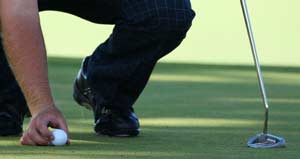The Hacker: Our dawdling leads to blame game but what's the rush?

Getting stuck behind dawdling golfers is one of the game's major frustrations and can often lead to heated arguments. We were involved in one at Royal Porthcawl last week – and my playing partner, John, and I were the ones accused of doing the dawdling.
Although totally innocent of the charge, I did find that there was a certain familiarity about the scene. At my home club, The Glamorganshire, the regular three-ball that I play medals in are often chided for slow play.
We have to admit we are not the quickest – and we do call others through when necessary – but it is too much to expect every three-ball to move at the same pace.
Our combined age is 219 years, our handicaps total 68 and, on average, we take almost 300 shots between us during a medal round.
The pace of three low handicappers under 40 would obviously be quicker and the ability to take a third fewer shots than us is a great help. There is also the matter of certain directional failings which means we spend more time looking for balls than them.
There are other groups who count their enjoyment of a round not only by the number of shots they take but by the number of minutes they take to complete the 18 holes. However, golf is not a game to be rushed.
Ask the professionals. Some of them defy every attempt to persuade them to get a move on.
In gale-force winds at Porthcawl last Wednesday, we weren't playing a competition and we certainly didn't expect a quick round. When we got to the first tee, there was a ladies two-ball halfway down the fairway and another two-ball waiting to tee off.
We waited for at least 10 minutes before we could drive off and then we waited to play our shots on to the green. All this was quite normal for starting a round on a crowded course.
On the third hole, one of the ladies two-balls had called the other two through and they had both disappeared over the ridge that crosses the fairway when we drove into the head-on wind.
I narrowly missed a deep cross-bunker but John's drive was held up by the wind and dropped into the sand. He took three to get out, finally having to play out sideways.
Neither of us noticed the presence on the tee of two blokes who had caught up with us. When we reached the par-three, there was another wait for the ladies to clear the green.
We didn't take long to finish that hole because I got a par and John picked up. We then had another wait on the fifth until the ladies got out of range.
And when we reached the sixth tee we had another wait, longer this time, before we could tee off. John went first and as I teed up, the two behind had caught up and I heard John say to them that he was sorry it was slow.
One of them then started complaining bitterly about being held up. I pointed at the distant ladies. "Don't blame them, it's your fault," he said.
"You took three to get out of a bunker. And then you raked it. You should have called us through then," he moaned.
We said we didn't even see them and even if we'd called them through, there would have been four groups on the same hole. We'd been waiting on nearly every shot since we began the round and they must have seen us.
He still chuntered on and, finally, in a rare exhibition of gentlemanliness, I stood back and invited them to play through. "No, our round is ruined, we're going to the 10th."
Ruined? You've only played five holes. But off they went in the highest of dudgeons.
We were flabbergasted and not a little ruffled. John's game was so affected that I managed to halve the match with him.
Maybe we shouldn't have become so indignant. For all we knew, the bloke might haveowned the place. Maybe, he just thought he did.
Simon Iliffe's tip of the week
No 90: Putting – Face over path
I see so many golfers who worry and fret on the putting green because their putting stroke is not spot on.
In truth, the path of your putting stroke is of very little importance compared to the putter face.
As an example, line up a relatively flat three-foot putt from the cup and putt five balls in the hole with an exaggerated cut across the ball (out-to-in path), but make sure that the putter face is facing the hole at impact. You'll see the ball follows the putter face, much more than the path, and you may even hole a couple of them.
Next time you're faced with a three-footer, concentrate on getting the face of the putter back to the ball square to the hole, NOT your stroke...
Simon Iliffe is head professional at Bramley Golf Club, Surrey. www.theshortgame.co.uk
Subscribe to Independent Premium to bookmark this article
Want to bookmark your favourite articles and stories to read or reference later? Start your Independent Premium subscription today.

Join our commenting forum
Join thought-provoking conversations, follow other Independent readers and see their replies